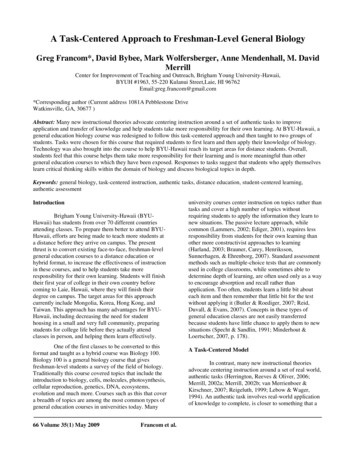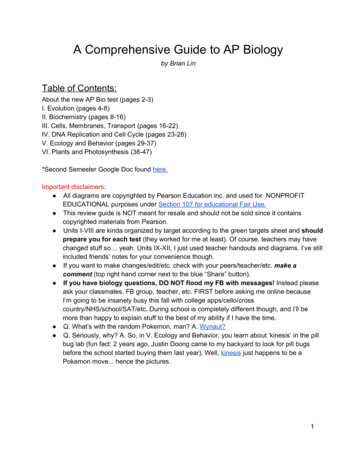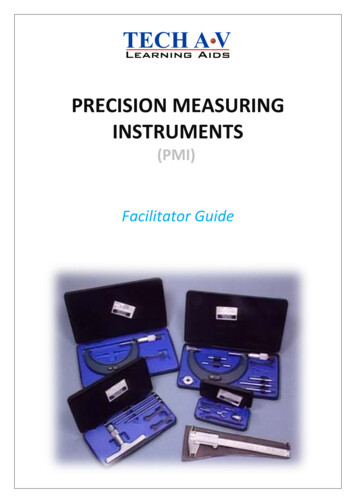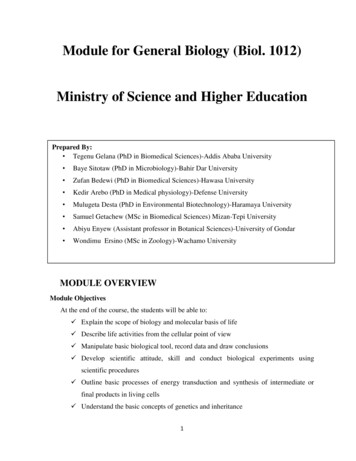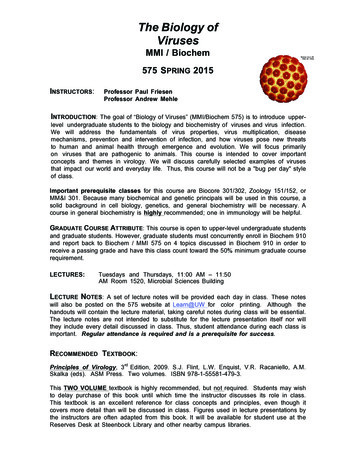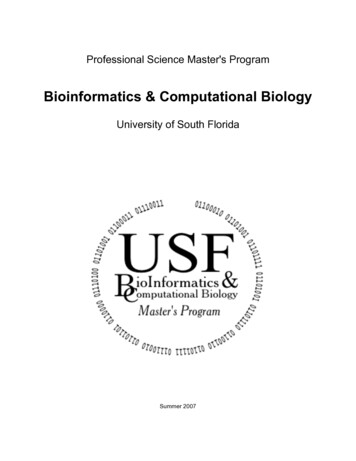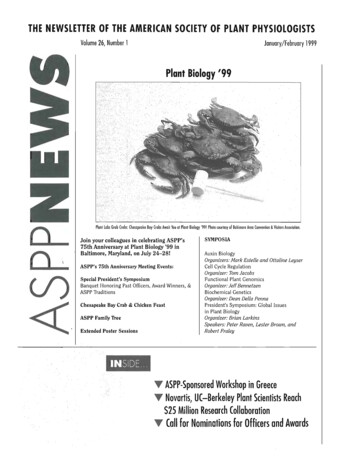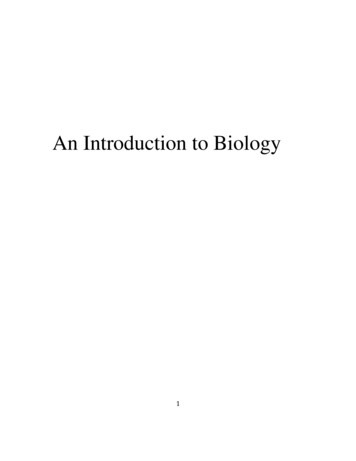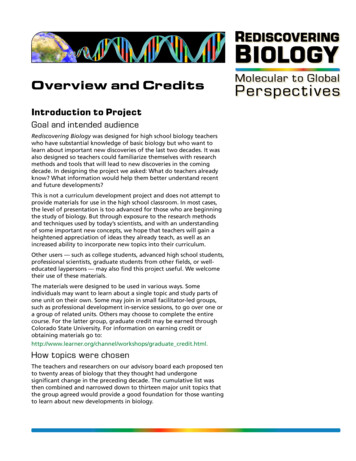
Transcription
REDISCOVERINGBIOLOGYOverview and CreditsIntroduction to ProjectGoal and intended audienceRediscovering Biology was designed for high school biology teacherswho have substantial knowledge of basic biology but who want tolearn about important new discoveries of the last two decades. It wasalso designed so teachers could familiarize themselves with researchmethods and tools that will lead to new discoveries in the comingdecade. In designing the project we asked: What do teachers alreadyknow? What information would help them better understand recentand future developments?This is not a curriculum development project and does not attempt toprovide materials for use in the high school classroom. In most cases,the level of presentation is too advanced for those who are beginningthe study of biology. But through exposure to the research methodsand techniques used by today’s scientists, and with an understandingof some important new concepts, we hope that teachers will gain aheightened appreciation of ideas they already teach, as well as anincreased ability to incorporate new topics into their curriculum.Other users — such as college students, advanced high school students,professional scientists, graduate students from other fields, or welleducated laypersons — may also find this project useful. We welcometheir use of these materials.The materials were designed to be used in various ways. Someindividuals may want to learn about a single topic and study parts ofone unit on their own. Some may join in small facilitator-led groups,such as professional development in-service sessions, to go over one ora group of related units. Others may choose to complete the entirecourse. For the latter group, graduate credit may be earned throughColorado State University. For information on earning credit orobtaining materials go te credit.html.How topics were chosenThe teachers and researchers on our advisory board each proposed tento twenty areas of biology that they thought had undergonesignificant change in the preceding decade. The cumulative list wasthen combined and narrowed down to thirteen major unit topics thatthe group agreed would provide a good foundation for those wantingto learn about new developments in biology.Molecular to GlobalPerspectives
R E D I S C OV E R I N G B I O L O GYThis is not a comprehensive treatment of the field of biology. Itincludes areas of study that may be entirely new to some, such asgenomics and proteomics. It also includes more traditional topics, suchas human evolution and neurobiology, which have changedsubstantially because of the application of new techniques. Indeed, acommon theme throughout the project is the application of processesand techniques at the molecular level to enlighten studies oforganisms, populations, or ecosystems.Assumptions about user knowledgeWe assume that users of this material have knowledge equivalent tothat of someone with a bachelor’s degree in a biological science. Mostterms and concepts that are used in a high school biology text are notdefined or explained. We also recognize that biology is a rapidlyadvancing field, and someone who graduated from college a decadeago could not have been exposed to some of what is taught today.Biology is also a huge field of study, and many students who graduatefrom college this year, even, will not have been exposed to all of thematerial collected here. Many of the concepts we explore can be foundin a recent introductory college biology textbook such as Freeman’sBiological Science, or Campbell and Reece’s Biology. Users might find ituseful to have access to such a text as an additional reference.Project ComponentsRediscovering Biology is a multimedia project. Each of the thirteenunits comprises a half-hour video, an online text chapter, and a set oflearning activities. The Web site provides access to all of these, as wellas additional resources, including: a glossary that serves as a navigational toolto other parts of the project interactive case studies transcripts from expert scientist interviews animations from the videos and case studies still images from the videos and text bookThe videos and the text chapters can be used independently; if bothare used, it is possible to start with either one. We imagine that mostusers will watch the video first, then read the chapter, and thenperhaps watch the video again.Each video includes interviews with two or more expert scientists.Through these interviews viewers will get a sense of how and whythese scientists do their research, and will have a look at some of theequipment and techniques they use. In choosing experts to interview,we looked for those who are nationally and internationallyrecognized, regardless of their gender or ethnicity. Should you wish toknow more about the work of a particular researcher featured in thevideos, the full transcripts from the interviews with these experts areavailable on the Web site.The Web site is both to organize the different components of theproject and a place to go for additional information. On the Web, acomprehensive glossary defines important terms used throughout theseries, and provides links to text and animations where these conceptsare explained or used. Animations from the videos are available on theWeb site so that users may study them in more detail, playing themOverview and CreditsComputer Graphics —Bergmann Graphics2
R E D I S C OV E R I N G B I O L O GYrepeatedly or pausing in the middle to study them. Transcripts ofinterviews of scientists provide a rare opportunity to get to knowscientists who are associated with many of the leading discoveries inbiology today and understand their research.Order of unitsUsers may decide to study all thirteen units or they may be interestedin a single one. Each unit is meant to stand alone, but we often referto ideas and techniques presented in other units. We have organizedthe units so that techniques such as microarray analysis or BLASTsearches, which are used in several units, are explained early in theseries. An html form of the text is available on the Web; from it usersmay navigate through the various units and the different components.Online textThe online text chapters are not simply a repeat of what is in thevideo. Rather, they show how information from the video fits into thelarger field. In other words, they provide context for the focusedexamples presented in the video. One central theme present in nearlyall of the chapters of the online text is the role that genetics andgenomic studies have had in increasing our understanding of thevarious fields of biology.Each chapter was written by one of three authors, selected for his orher knowledge of biology and ability to write clearly about thatknowledge. All of these authors have taught at the college level. Thechapters vary somewhat in style and level of difficulty; thesedifferences result both from the nature of the material itself, as well asfrom differences among writers.AuthorsAmy Does, PhD, is a microbiology instructor at Portland CommunityCollege in Portland, Oregon. In addition to teaching prenursingstudents, she provides professional development for elementary schoolteachers who conduct afterschool science clubs. She has developedexhibits for a science museum, designed science software for middleschool students, and taught college-level biology online. Amy is theauthor of the Microbial Diversity, Emerging Infectious Diseases, HIVand AIDS, and Genetically Modified Organisms chapters.Norman A. Johnson, PhD, is an adjunct research assistant professorat the University of Massachusetts at Amherst. His research has focusedon speciation and several other areas of evolutionary genetics. Inaddition to the University of Massachusetts, Norman has also taught atthe University of Chicago and the University of Texas at Arlington.Norman served as the style editor for all thirteen chapters, and is theauthor of the Evolution and Phylogenetics, Genetics of Development,Human Evolution, Neurobiology, and Biodiversity chapters.Teresa Thiel, PhD, is a professor of biology at the University ofMissouri-St. Louis. Her main interests are molecular biology,microbiology, and bioinformatics. She directs a program for high schoolteachers and students called “Science in the Real World: Microbes inAction” that includes a Web site of the same name. She teachesmicrobiology and microbial genetics to undergraduate and graduatestudents, and offers summer workshops in microbiology for teachers.Overview and Credits3
R E D I S C OV E R I N G B I O L O GYTeresa is the author of the Genomics, Proteins and Proteomics, CellBiology and Cancer, and Biology of Sex and Gender chapters.Learning activitiesEach unit contains several learning activities tailored to theinformation in the unit. These activities include simple review anddiscussion questions; exercises that demonstrate how data aregenerated, interpreted, and applied; explorations of ethical issues; andconsideration of how the information relates to other fields. Most ofthe activities assume the participants are familiar with the unit’s videoand online text.Case studiesFour interactive Web-based case studies showcase a specific area ofapplied or basic research in cancer, comparative evolution, HIV, orgenetically modified organisms. Each case study takes the participantthrough a series of steps in a research project. After viewingexplanatory and background material on the project, the participantchooses an experiment to perform or a hypothesis to test. The casestudies provide an interactive experience that complements the videoand text chapters; and provide a window into the choices, challenges,compromises, and rewards associated with one area of biologicalinquiry. Each case study is an independent activity but may incorporateinformation from more than one unit.Because the case studies go into greater depth than the videos andtexts, and rely on information from them, it is best to do them aftercompleting the other components. The first Web page of each casestudy provides links to the videos and online texts that are relevant tothe study.WritersChris Tachibana, PhD, has taught undergraduate biology since 1992at Salt Lake Community College, Penn State University, and theUniversity of Washington. She is a research scientist at the University ofWashington Biochemistry Department and the Carlsberg Research Labsin Denmark. Chris developed two case studies: The Genetics ofResistance to HIV and Designing an Anti-Cancer Drug. She alsoauthored the learning activities for the Genomics, Proteins andProteomics, Emerging Infectious Diseases, HIV and AIDS, Cell Biologyand Cancer, Biology of Sex and Gender, and Genetically ModifiedOrganisms units. In addition, she produced the learning activity courseguides for all thirteen units, and gave the learning activites for all unitsa common voice.Andrea (Andi) White, PhD, is a postdoctoral research associate at theUniversity of California, Berkeley. As a graduate student at theUniversity of New Hampshire she was a teaching assistant for marineecology, honors biology, economic botany, and a lab coordinator forplant biology. Her current research interests focus on algal stressphysiology and biochemistry, and the generation of environmentallyfriendly, alternative fuel sources from green algae. Andi developedtwo case studies: Evolution of Tungara Frog Mating Calls and PlantGenetic Modification. She also authored learning activities for theEvolution and Phylogenetics, Microbial Diversity, Genetics ofDevelopment, Human Evolution, Neurobiology, and Biodiversity units.Overview and Credits4
R E D I S C OV E R I N G B I O L O GYNorman A. Johnson, PhD, (see biography under online author) alsocontributed to the learning activities for the Evolution andPhylogenetics, Microbial Diversity, Genetics of Development, HumanEvolution, Neurobiology, and Biodiversity units.Project TeamAdvisorsIn addition to determining the content of the units, our advisors andconsultants have been actively involved in reviewing the material forall thirteen units throughout its development. Videos, animations, casestudies, and text chapters have all been reviewed several times duringtheir production for accuracy and to ensure that these materials are asuseful as possible to the intended audience.Our primary advisors and consultants consisted of a team of eightscientists involved in teaching, curriculum development, and research.Mark Bloom, PhD, is a science educator at Biological SciencesCurriculum Study (BSCS). He has developed print and Web-basedcurriculum materials for students in middle school, high school, andcollege. Previously, he was the assistant director of the Dolan DNALearning Center, where he ran workshop programs for high school andcollege teachers. He developed the first educational kits using thepolymerase chain reaction and coauthored the college lab manualLaboratory DNA Science. Mark was lead advisor for the Genomics,Proteins and Proteomics, Cell Biology and Cancer, and Biology of Sexand Gender units.Steve Boyarsky is the coordinator of curriculum improvement at StaffDevelopment at Southern Oregon Education Service District. Stevecoordinates professional development in a three-county region insouthern Oregon. He taught high school biology and humananatomy/physiology for 18 years. Steve has been involved with stateand national level biology education through the National ScienceTeachers Association, a congressional fellowship, grants, andcurriculum projects. Steve commented on appropriateness of content,level, and style of all project components.Alan Dickman, PhD, is the biology curriculum director and anassociate professor of biology at the University of Oregon. He hasorganized summer outreach programs in science for middle school,high school, and community college teachers, and has been involved innationally funded programs to improve college-level biologyeducation. Alan teaches introductory biology courses and an upperdivision forest biology course. As lead scholar, Alan was responsible forfinal scholarly quality of all content of all project components.Marion Field Fass, ScD, is an associate professor of biology at BeloitCollege. She has been involved in curriculum reform efforts in biologythrough the BioQUEST Curriculum Consortium and the SENCER (ScienceEducation for New Civic Engagements and Responsibilities) project ofAAC&U. In 2002 she traveled to Kenya and Tanzania to work withprofessors who were developing undergraduate courses about theepidemic of HIV/AIDS and about its impact in their communities. Marionwas lead advisor for the Microbial Diversity, Emerging InfectiousDiseases, HIV and AIDS, and Genetically Modified Organisms units.Overview and Credits5
R E D I S C OV E R I N G B I O L O GYPaula Henderson has taught biology at Newark High School inNewark, Delaware since 1980, and received the Outstanding BiologyTeacher award for Delaware in 1993. She has taught a course in humanheredity and development at the University of Delaware, and is acoauthor of the NIH/BSCS module “The Brain: UnderstandingNeurobiology Through the Study of Addiction.” Paula commented onappropriateness of content, level, and style of all project components.Patrick Phillips, PhD, is an associate professor of biology and amember of the Center for Ecology and Evolutionary Biology at theUniversity of Oregon. His research focuses on theoretical and empiricalstudies of evolutionary genetics. He teaches foundations of biology,evolution, population genetics, and experimental design; and is thecreator of the evolutionary biology Web site, EvoNet.org. Patrick waslead advisor for the Evolution and Phylogenetics, Genetics ofDevelopment, Human Evolution, Neurobiology, and Biodiversity units.John Postlethwait, PhD, is a professor of biology in the Institute ofNeuroscience at the University of Oregon. His research interest is indevelopmental genetics; he and his group have discovered a genomeduplication event that occurred before the vast radiation of teleostfish, which account for half of all species of vertebrates. His lab iscurrently investigating the genetic mechanisms that may help accountfor that explosion of biodiversity. The author of two non-majorstextbooks for college students, John is committed to undergraduateeducation and has taught introductory biology to mostly non-biologymajors since 1964. John provided critical assistance for the Genetics ofDevelopment unit and parts of several other units.Carol Wheeler is a biology teacher and department chair at PineCreek High School in Colorado Springs, Colorado. She worked inmedical research and was a certified histocompatibility technologistprior to teaching. She received a Christa McAuliffe grant to develop amolecular biology course, and an Intel grant designed to help getstudents eligible to compete in science fairs at the international level.Carol commented on appropriateness of content, level, and style of allproject components.EvaluationIn addition to the guidance from our team of advisors and consultants,an independent formative evaluation of three of the thirteen unitswas conducted by RMC Research Corporation. RMC Research staffselected ten biology teachers and ten professional developmentproviders, who varied with respect to geographic location, race andethnicity, and background knowledge in biology. These reviewersprovided helpful input on these three units while they were beingdeveloped; suggestions made on these units were generalized, whereappropriate, to the other ten units.FunderRediscovering Biology is funded by Annenberg/CPB, a partnershipbetween the Annenberg Foundation and the Corporation for PublicBroadcasting (CPB), which uses media and telecommunications toadvance excellent teaching in American schools. Annenberg/CPB videoshelp teachers increase their expertise in their fields and improve theirteaching methods. For information on obtaining Annenberg/CPBmaterials, go to www.learner.org or call 1-800-LEARNER.Overview and Credits6
R E D I S C OV E R I N G B I O L O GYProducerOregon Public Broadcasting (OPB) is a highly experienced producer ofeducational content with expertise in both traditional and new mediaapproaches to formal education, community outreach, and televisionproduction.OPB has produced many series for Annenberg/CPB, including THEUNSEEN UNIVERSE: An Introduction to Microbiology; A WORLD OFART: Works in Progress, a series on contemporary artists; AMERICANPASSAGES: A Literary Survey, a multimedia series for college students;and ARTIFACTS & FICTION, a professional development workshop seriesfor teachers on interdisciplinary approaches to American literature.OPB has also been the co-producer for video series and digitalmaterials to accompany several McGraw-Hill textbook publications.OPB has a long history of producing Web sites, teachers’ guides, andother curriculum materials to accompany educational and PBSbroadcast series. Working in close concert with national advisoryboards, OPB’s staff has produced curriculum materials in thehumanities and sciences for a variety of grade levels and teacherprofessional development.OPB is also a major producer of PBS Primetime documentary series, andhas created programming for NOVA, FRONTLINE, and other programsas well as numerous specials and limited series.Research StaffRediscovering Biology would not be possible without the hard work ofthe research and production staff at Oregon Public Broadcasting. Theresearch staff provided critical support for video producers, authors,and activity developers.Cindy Lefton has a bachelor’s degree in zoology and a master’sdegree in mass communication with an emphasis on science writingand editing. She has served as the editor of a medical news magazine,and has edited several medical textbooks and journal articles. Herinterests in science and nature have lead to volunteer service as aneducation coordinator for a wildlife rehabilitation facility, a zoo guide,and a science fair coordinator.Liza Nicoll earned a bachelor’s degree in biology and a bachelor’sdegree in health science at the University of Massachusetts at Amherstin the spring of 2001. Since completing work on Rediscovering Biologyshe has continued to work in television production, researching for aworld history documentary series.Stephani Sutherland earned a doctorate in neuroscience from theVollum Institute at Oregon Health & Science University, where shecoordinated an outreach program in public junior high and highschools called Kids Interested in Discovering Science (KIDS). Sinceleaving the research laboratory in 2001, she has worked as a sciencenews reporter for the Los Angeles Times and traveled around theworld. She now works for the Journal of Neuroscience and writesfreelance science news for various journals. Stehpani was also acoauthor for the Neurobiology chapter of the online text.Overview and Credits7
R E D I S C OV E R I N G B I O L O GYIntervieweesWe are grateful to so many of these people who were willing to findtime for this project. The following people provided valuableinformation to the project through interviews.Genetically Modified OrganismsLeon Corzine; David L. Dornbos, Jr., PhD; Rebecca J. Goldburg, PhD;Marion Nestle, PhD, MPH; Thomas E. Newberry; and Gary H.Toenniessen, PhD.Emerging Infectious DiseasesCapt. Daniel Carucci, MD, PhD; Rita Colwell, PhD; Laurie Garrett;Stuart B. Levy, MD; Judith M. Martin, MD; and Lukas K. Tamm, PhD.Cell Biology CancerElizabeth Blackburn, PhD; Brian Druker, MD; Leland Hartwell, PhD;Mary-Claire King, PhD; and Robert Weinberg, PhD.Biology of Sex and GenderHolly Ingraham, PhD; David Page, MD; and Eric Vilain, MD, PhD.GenomicsDavid Altshuler, MD, PhD; James Carrington, PhD; Jonathan Eisen, PhD;and Eric Lander, PhD.Proteins and ProteomicsHamid Bolouri, PhD; Ned David, PhD; Stanley Fields, PhD; HunterFraser; Aaron Hirsh; and Leroy Hood, PhD.Microbial DiversityAnne Camper, PhD; Bill Costerton, PhD; Dan Kotansky, PhD; AnnaLouise Reysenbach, PhD; Frank F. Roberto, PhD; Phil Stewart, PhD;and Paul Sturman.HIV and AIDSEdward Berger, PhD; Laurie Garrett; Jay Levy, MD;Rob Roy MacGregor, MD; Erik Vonmuller; and David Weiner, PhD.Evolution and PhylogeneticsPhillip Gingerich, PhD; Timothy Read, PhD; and Carl Woese, PhD.Human EvolutionKari Stefansson, MD; Ian Tattersall, PhD; Ajit Varki, MD;and Christopher Wills, PhD.NeurobiologyWolfhard Almers, PhD; Fred Gage, PhD; Richard Huganir, PhD;and John Williams, PhD.BiodiversityJames Miller, PhD; Richard Ostfeld, PhD; Peter H. Raven, PhD;Eleanor Sterling, PhD; and G. David Tilman, PhD.Genetics of DevelopmentJudith Eisen, PhD; Markus Grompe, MD; John Incardona, PhD; NipamPatel, PhD; and John Postlethwait, PhD.Overview and Credits8
R E D I S C OV E R I N G B I O L O GYAdditional AcknowledgementsWe would like to thank the following people at Oregon PublicBroadcasting in addition to the researchers who made thisproject possible.Executive Producer Meighan Maloney; Production Manager Doug Brazil;Production Media Manager Catherine Stimac; Production AssignmentManager Joshua Wolfe; Web Developer John Kin; Web Assistant RyanServatius; Assistant Production Manager Mary Hager; DatabaseAdministrator Heather Chambers; and Copyeditor Jennifer Ingraham.The Rediscovering Biology video series was produced by Oregon PublicBroadcasting’s Educational Media Production Department. The creativeteam consisted of the following: Executives in Charge of ProductionDavid Davis and Jack Galmiche; Executive Producer Meighan Maloney;Producer/Writers Melissa Gerr, Nadine Jesling, Amanda Lowthian, andEric Slade; Writer Andrew Holtz; Series Host Lew Frederick; AcademicDirector Alan Dickman; Production Assignment Manager Joshua Wolfe;Production Manager Doug Brazil; Production Media ManagerCatherine Stimac; Researchers Cindy Lefton, Liza Nicoll, and StephaniSutherland; Director of Production Services Milt Ritter; Manager ofProduction Scheduling Bill Dubey; Director of Engineering InformationDave Fulton; Assistant Director Sean Hutchinson; Assistant ProductionManager Mary Hager; Pre-Production Coordinator Thea Bergeron;Videographers Art Adams, Karel Bauer, S.O.C., David Dennison, PaulJacobson, Lisa Suinn Kallem, Jim Langley, Michael McNamara, CorkyMiller, Ben Nieves, John Patzer, Todd Sonflieth, Dave Spangler, andWally Szczubialk; Editors Tom Babich, Bruce Barrow, Sarah Marcus,Chris Nolan, John Patzer, and Kate Schoninger; Field Audio Michael A.Bidese, Chad Birmingham, Darren Brower, Kevin Brown, Chris Callus,Francis X. Coakley, Tony D’Annunzio, Thom Dentler, Jay Farrington,Dave Foreman, Thomas Forliti, Gerry Formicola, G. John Garrett, JoelGroeblinghoff, Cindy Hogan, Chip Lake, Randy Layton, GordonMasters, Casey Quinlan, C.A.S, Todd Schmidt, Brandt Sennhenn, MikeTyrey, Ted Ver Valen, Bill Ward, and Matt Yeasley; Creative Director TimBergmann; Production Artists Dora Papay, Corrina Reff, and JeffersonP. Vowell; 3-D Animations Hot Pepper Studios, Animation Dynamics,Inc., and Kevin Washington; Rights Assistant Morgan Currie; ThemeMusic Cal Scott; Production Intern Larry Johnson; Production ArtInterns Soumalay Douangmala, Kim Harshberger, and Kevin Jaquette;Production Assistants Michael Aaris, David Banyan, Emily Chapman,Mike Forest, Kenyatta Gomez, Madeleine Pappas, Michelle Pridemore,Anastasia Savko, Alex Selkowitz, and Jonathan Zintel.The Rediscovering Biology Web Site was produced by the followingcreative team: Oregon Public Broadcasting Web Developer/ProducerJohn Kin; Web Assistant Ryan Servatius; Database AdministratorHeather Chambers; Project Coordination, Flash InteractiveDevelopment and Project Design AMAZING! Online Marketing,LLC in association with Moshofsky/Plant Creative Services andBergmann Graphics.Overview and Credits9
Biology is also a huge field of study, and many students who graduate from college this year, even, will not have been exposed to all of the material collected here. Many of the concepts we explore can be found in a recent introductory college biology textbook such as Freeman’s Biological Science, or


